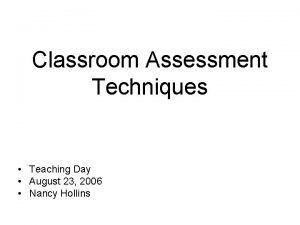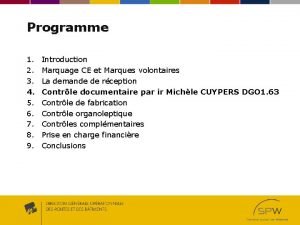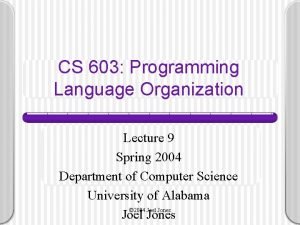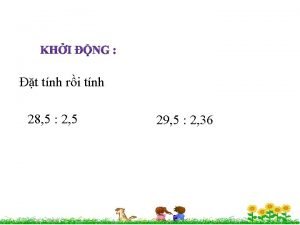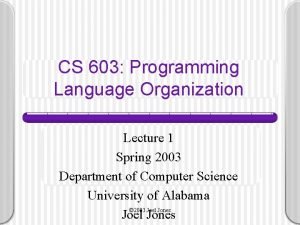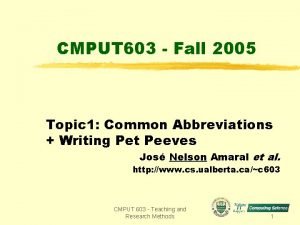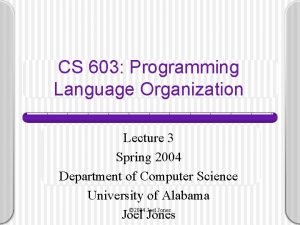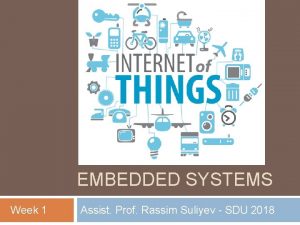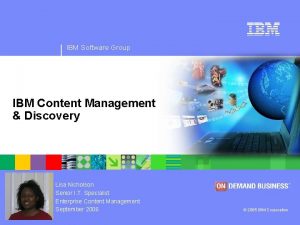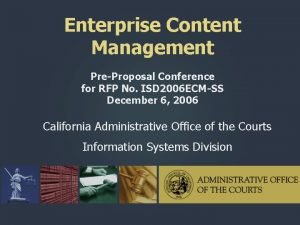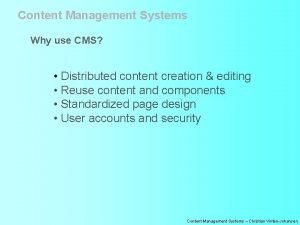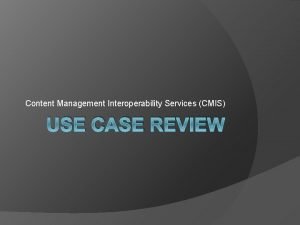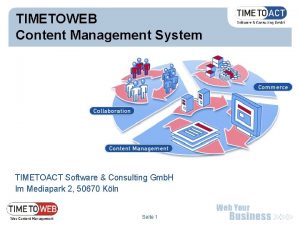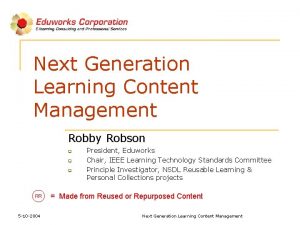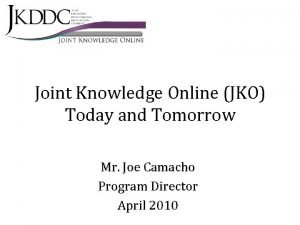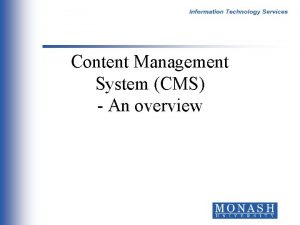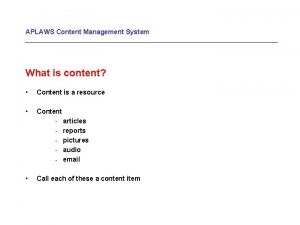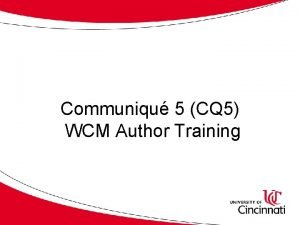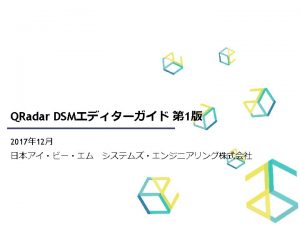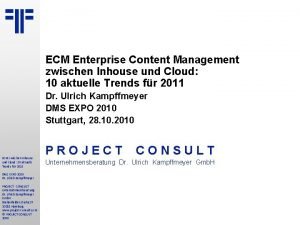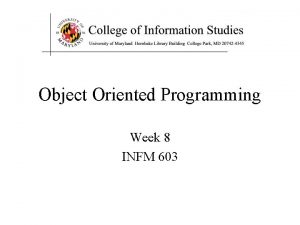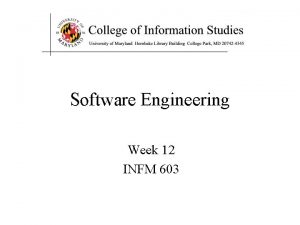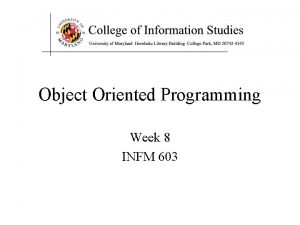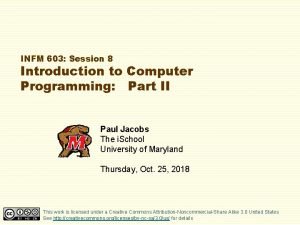Content Management Systems Week 9 INFM 603 Muddiest














































- Slides: 46

Content Management Systems Week 9 INFM 603

Muddiest Points • How JSON differs from XML – And how JSONP differs from JSON • How Ajax works • Examples of Java. Script without Ajax • How to make an API • Can API’s be used by anyone?

Agenda • Questions • Drupal • Project Plan • Human-Computer Interaction

• Relational normalization • Structured programming • Software patterns • Object-oriented design • Functional decomposition Business Interaction Design rules Interface Design Client Hardware Web Browser Client-side Programming Interchange Language Server-side Programming (PC) (IE, Firefox) (Java. Script) (HTML, XML) (PHP) Database (My. SQL) Server Hardware (PC, Unix)

Content Management Systems • Database to store content – Also stores access control data and parameters • PHP to control user experience – Reads database, generates HTML – “Canned” settings provide standard behaviors • HTML to convey user experience • Allows limited interactivity – Most user actions require a server response – Java. Script may be used form validation

Information Architecture • The structural design of an “information space” to facilitate access to content • Two components: – Static design – Interaction design

Static Design • Organizing principles – Logical: – Functional: – Demographic: e. g. , chronological, alphabetical by task by user • Metaphors – Organizational: – Physical: – Functional: – Visual: e. g. , e-government e. g. , online grocery store e. g. , cut, paste e. g. , octagon for stop

“Site Blueprint” Main Homepage Teaching Research Other Activities LBSC 690 Ph. D. Students IR Colloquium INFM 718 R Publications TREC Doctoral Seminar Projects

Grid Layouts Navigation Bar Content Related Links Navigation Bar Content

Grid Layout: NY Times

Grid Layout: NY Times Navigation Banner Ad Another Ad Content Popular Articles

Grid Layout: ebay

Grid Layout: ebay Navigation Banner Ad Navigation Related Search Results

Grid Layout: Amazon

Grid Layout: Amazon Navigation Related Search Results

Some Layout Guidelines • Contrast: make different things different – to bring out dominant elements – to create dynamism • Repetition: reuse design throughout the interface – to achieve consistency • Alignment: visually connect elements – to create flow • Proximity: make effective use of spacing – to group related and separate unrelated elements

Interaction Design • Chess analogy: a few simple rules that disguise an infinitely complex game • The three-part structure – Openings: many strategies, lots of books about this – End game: well-defined, well-understood – Middle game: nebulous, hard to describe • Information navigation has a similar structure! – Middle game is underserved From Hearst, Smalley, & Chandler (CHI 2006)

Opening Moves

Opening Moves

Opening Moves

Middle Game

Middle Game

Navigation Patterns • Drive to content • Drive to advertisement • Move up a level • Move to next in sequence • Jump to related

Drupal Structure • Regions – Header, left sidebar, content, right sidebar, footer – Structure->Blocks->Demonstrate Blocks Region • Blocks – Navigation, login, Drupal, help, content, search – Optional: who’s online, recent comments, … • Menus – Main, navigation, user

Drupal Content (“Nodes”) • Basic Page • Article – By default allows comments • Blog entry • Forum topic

Optional Drupal Modules • • • Aggregator Blog Forum Book Contact form Poll Search Statistics Trigger Translation

Some Downloadable Modules • • Content Construction Kit Views Open. Layer Dynamic Display Block Embedded Media Image Cache Calendar Share

Installing Drupal • Download and install XAMPP – Add c: xamppmysqlbin to your path • Download and install Drupal version 7. x – Configure for local use (“first time user guide”) – Ignore SMTP error messages • Configure your site – Add some “splash page” content – Set user permissions

Drupal’s Use of My. SQL USE drupal; SHOW TABLES; SELECT * FROM users; SELECT * FROM node_revisions;

Modifying Drupal • Work with what’s there – Content – Configuration • • Download a distribution profile Edit the CSS files Edit the PHP code Edit the database contents

Agenda • Questions • Drupal Ø Project Plan • Human-Computer Interaction

The Project Plan • One-page contract • • Goal Product Scope Roles The problem to be solved What you plan to deliver Available time and personnel What you expect each other to do

What are Requirements? • Attributes – Appearance – Concepts (represented by data) • Behavior – What it does – How you control it – How you observe the results

The Requirements Interview • Focus the discussion on the task – Look for entities that are mentioned • Discuss the system’s most important effects – Displays, reports, data storage – Learn where the system’s inputs come from – People, stored data, devices, … • Note any data that is mentioned – Try to understand the structure of the data • Shoot for the big picture, not every detail

Agenda • Questions • Drupal • Project Plan Ø Human-Computer Interaction

Human-Computer Interaction A discipline concerned with the Implementation Design Evaluation of interactive computing systems for human use

Synergy • Humans do what they are good at • Computers do what they are good at • Strengths of one cover weakness of the other

Interaction • Forming an intention – Internal mental characterization of a goal • Selection of an action – Review possible actions, select most appropriate • Execution of the action – Carry out appropriate actions with the system • Evaluation of the outcome – Compare results with expectations

Stages of Interaction Goals Intention Expectation Selection Evaluation Interpretation Mental Activity Physical Activity Execution System Perception

Challenges of HCI Goals Intention Expectation “Gulf of Execution” Evaluation “Gulf of Evaluation” Selection Interpretation Mental Activity Physical Activity Execution System Perception

What is good design? Goals Intention Expectation Evaluation Mental Model Selection Interpretation Mental Activity Physical Activity Execution System Perception

Modeling Interaction Human Mental Models Task System Software Models Task Computer User Sight Sound Hands Voice Keyboard Mouse Display Speaker

Mental Models • How the user thinks the machine works – What actions can be taken? – What results are expected from an action? – How should system output be interpreted? • Mental models exist at many levels – Hardware, operating system, and network – Application programs – Information resources

Evaluation Approaches • Formative vs. summative • Extrinsic vs. intrinsic • Quantitative vs. qualitative – Deductive vs. inductive • User study vs. simulation

Evaluation Examples • Direct observation – Evaluator observes users interacting with system • in lab: user asked to complete pre-determined tasks • in field: user goes through normal duties – Validity depends on how contrived the situation is • Think-aloud – Users speak their thoughts while doing the task – May alter the way users do the task • Controlled user studies – Users interact with system variants – Correlate performance with system characteristics – Control for confounding variables

Evaluation Measures • Time to learn • Speed of performance • Error rate • Retention over time • Subjective satisfaction
 Muddiest point examples
Muddiest point examples Muddiest point examples
Muddiest point examples Muddiest point examples
Muddiest point examples Week by week plans for documenting children's development
Week by week plans for documenting children's development Content management system database
Content management system database What is esp
What is esp Static content vs dynamic content
Static content vs dynamic content 603 550 israelites
603 550 israelites Groutex 603
Groutex 603 750 ilcs 5/603
750 ilcs 5/603 Keno 603 past winning numbers
Keno 603 past winning numbers Cs 603
Cs 603 28,5:2,5
28,5:2,5 Cs 603
Cs 603 Cmput 603
Cmput 603 Drymix plasters renders ceramics
Drymix plasters renders ceramics Cs 603
Cs 603 Embedded systems week
Embedded systems week Management week event
Management week event Management week event
Management week event Ibm content management system
Ibm content management system Content management system
Content management system Ecm rfp
Ecm rfp Ibm ecm cloud
Ibm ecm cloud Distributed content management
Distributed content management Ortak portal
Ortak portal Content management interoperability services
Content management interoperability services Timetoact software & consulting gmbh
Timetoact software & consulting gmbh Learning content management system open source
Learning content management system open source Workplace web content management
Workplace web content management Robby robson
Robby robson Joint knowledge online learning content management system
Joint knowledge online learning content management system Swot for event planning
Swot for event planning Ecm wiesbaden
Ecm wiesbaden Content management system project plan
Content management system project plan Apkaws
Apkaws Umbraco content management system
Umbraco content management system Igloo content management system
Igloo content management system Cq5 web content management
Cq5 web content management Content management system statistics
Content management system statistics Rfp best practise
Rfp best practise Logrun.pl qradar
Logrun.pl qradar Open source enterprise content management
Open source enterprise content management Forrester wave web content management
Forrester wave web content management Emc content management
Emc content management Magic quadrant for enterprise content management 2004
Magic quadrant for enterprise content management 2004 Enterprise content management definition
Enterprise content management definition


